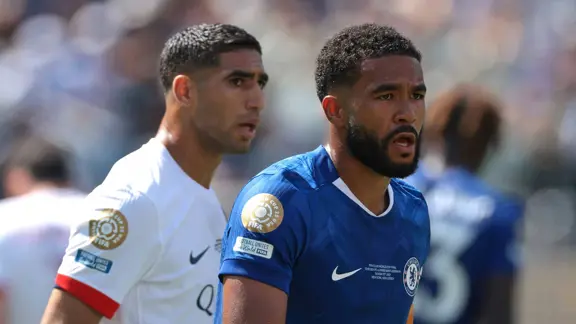News
New FIFPRO player workload report outlines continuing threats to player health and performance

- Many FIFA Club World Cup teams didn't get enough rest and preparation time before new season began
- Continuous competition cycles without minimum protections impact both health and performance at elite level
- The world’s top young players face excessive match exposure despite developmental vulnerability
Players which competed in the FIFA Club World Cup after their domestic league season are among hundreds at the top of men's football who lack adequate offseason or preseason periods, increasing risks to player health and performance, according to the annual FIFPRO Player Workload Monitoring Report published in collaboration with Football Benchmark.
Maheta Molango, FIFPRO board member, said: "This report gives you the factual evidence of what is happening in football. Players are either getting injured or not being able to perform at their best because they are pushed to their limit."
Club World Cup timing underlines elite calendar crisis
Chelsea, the FIFA Club World Cup winners, and runners-up Paris Saint-Germain were the hardest hit by the calendar crunch: after having their holiday period reduced to barely three weeks, Chelsea players had just 13 days for preseason, while PSG players got only seven days.
These findings underscore the urgent need for common-sense player safeguards like those in a recently-published Consensus Study on Minimum Player Workload Safeguards, in which high-performance experts agreed players should receive 28 days offseason and a further 28 days preseason.
The 2024/25 season report, entitled 'Overworked and Underprotected: The Player Health and Performance Impact’ uses data from 1,500 men's football players tracked on FIFPRO's Player Workload Monitoring platform, benchmarking their rest and recovery against recommendations from 70 medical and performance experts working for clubs and national teams. The report also looks at recovery time in other sports and, for the first time, incorporates extreme heat as a growing factor for performance, health, and competition planning.
International tournament players need more rest
Many other players at the top of the game are also short on rest and recovery: only 14 percent of the 2024 UEFA European Championship participants in the sample had the recommended 28 days of offseason rest before last season, dropping to just nine percent for Copa America participants who play in Europe's top five leagues. Post-tournament preparation was equally inadequate: only 15 percent had sufficient preseason after the EURO, and just four percent after the Copa America.
Dr. Darren Burgess, chair of FIFPRO's High-Performance Advisory Network, said football should follow other sports in guaranteeing offseason breaks to protect players from injury and burnout. NBA and Australia's AFL players get 14 weeks off, while Major League Baseball players have 15 weeks.
"If you don't have enough off-season, you don't give your body enough time mentally and physically to freshen up," Dr. Burgess said. “Plus, not having 28 days as a minimum of preseason prevents players doing rigorous preparation for the season ahead. It leads at worst to injury, and at best reduced capacity to perform. In other sports, the priority has been placed on player performance and player well-being, and the offseason break is a substantial part of that."
Fixture congestion and travel create health risks
While many players in football’s pyramid lack competitive games, those at the elite level are often overburdened: the health risks for players become disproportionate to elite sports’ inherent risks when they face sustained periods of two games per week, according to scientific research. The following were among players who experienced extreme fixture congestion with more than 50 games last season, many of which were with less than five days of recovery time:
- Real Madrid: Federico Valverde, Luka Modric
- Barcelona: Pedri, Raphinha
- Atletico Madrid: Julian Alvarez
- Bayern Munich: Min-Jae Kim (*)
Recovery time after international windows is often less than 48 hours – a smaller break than experts recommend – even for South Americans facing long-haul travel back to European and U.S. clubs. Argentina's Enzo Fernandez exemplified this burden, accumulating 195 hours of travel during 29 journeys spanning 149,010 kilometres last season.
Chris Wood, the New Zealand captain who is a member of the FIFPRO Global Player Council, said: "For us as players it's vitally important that we have the recovery period to allow the body to adapt and go again. We need to make sure that we are looking after our body in the long term. It's key we look at the minimum rest process and especially the preseason."
Young players at particular risk of damage
The consensus study identified specific workload safeguard needs for academy players under 18, with more research required for those under 21. However, evidence shows little caution: Lamine Yamal played 130 games before his 18th birthday in July, while Archie Gray, who turned 19 in March, appeared in 80 squad selections for Tottenham and England's Under-21 team last season.
Dr. Burgess emphasised that younger players need age-appropriate training loads, clear match exposure limits, and protected rest periods: "Growth plates, tendons, and ligaments remain vulnerable during these years, and excessive high-speed running or short recovery windows can lead to long-term structural damage,” he said. “The psychological toll should also not be underestimated."
To read a double-page spread of the report, head HERE.
*Min-Jae Kim had a 73-day stretch of back-to-back matches through mid-December 2024 with a game every 3.6 days on average and played much of season with an Achilles tendon injury.
